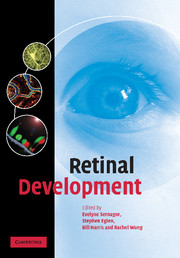Book contents
- Frontmatter
- Contents
- List of contributors
- Foreword
- Preface
- Acknowledgements
- 1 Introduction – from eye field to eyesight
- 2 Formation of the eye field
- 3 Retinal neurogenesis
- 4 Cell migration
- 5 Cell determination
- 6 Neurotransmitters and neurotrophins
- 7 Comparison of development of the primate fovea centralis with peripheral retina
- 8 Optic nerve formation
- 9 Glial cells in the developing retina
- 10 Retinal mosaics
- 11 Programmed cell death
- 12 Dendritic growth
- 13 Synaptogenesis and early neural activity
- 14 Emergence of light responses
- New perspectives
- Index
- Plate section
- References
2 - Formation of the eye field
Published online by Cambridge University Press: 22 August 2009
- Frontmatter
- Contents
- List of contributors
- Foreword
- Preface
- Acknowledgements
- 1 Introduction – from eye field to eyesight
- 2 Formation of the eye field
- 3 Retinal neurogenesis
- 4 Cell migration
- 5 Cell determination
- 6 Neurotransmitters and neurotrophins
- 7 Comparison of development of the primate fovea centralis with peripheral retina
- 8 Optic nerve formation
- 9 Glial cells in the developing retina
- 10 Retinal mosaics
- 11 Programmed cell death
- 12 Dendritic growth
- 13 Synaptogenesis and early neural activity
- 14 Emergence of light responses
- New perspectives
- Index
- Plate section
- References
Summary
Introduction
Vertebrate eyes originate from a single field of neuroectodermal cells in the anterior region of the neural plate called the eye field (sometimes referred to as the eye anlage, eye primordia or presumptive eye). The origins of the eye field can be traced back to the 32-cell-stage blastula in which a subset of blastomeres is competent, but not yet committed, to form retina. This chapter begins with a discussion of retinal competence and the maternal molecules and cell–cell interactions that take place in and bias early blastomeres toward a retinal fate. Transplantation experiments have shown that the entire presumptive neural plate of midgastrula embryos can form retina, demonstrating the remarkable coordination of neural development with eye formation. Neural induction and the neural patterning events critical for defining where the eye field forms in the developing nervous system will be addressed. Cultured amphibian anterior neural plates form eyes demonstrating that the eye field is specified (committed to form the eye) by the neural plate stage. A conserved set of transcription factors collectively referred to as eye field transcription factors are required for normal eye formation and are expressed in the eye field of the neural plate stage embryo. These genes and their functional interactions, which are required for and under some circumstances sufficient to drive eye field and eye formation will be described. A description of how the single vertebrate eye field separates to form the eye primordia that eventually give rise to the two eyes concludes this chapter.
- Type
- Chapter
- Information
- Retinal Development , pp. 8 - 29Publisher: Cambridge University PressPrint publication year: 2006
References
- 5
- Cited by



